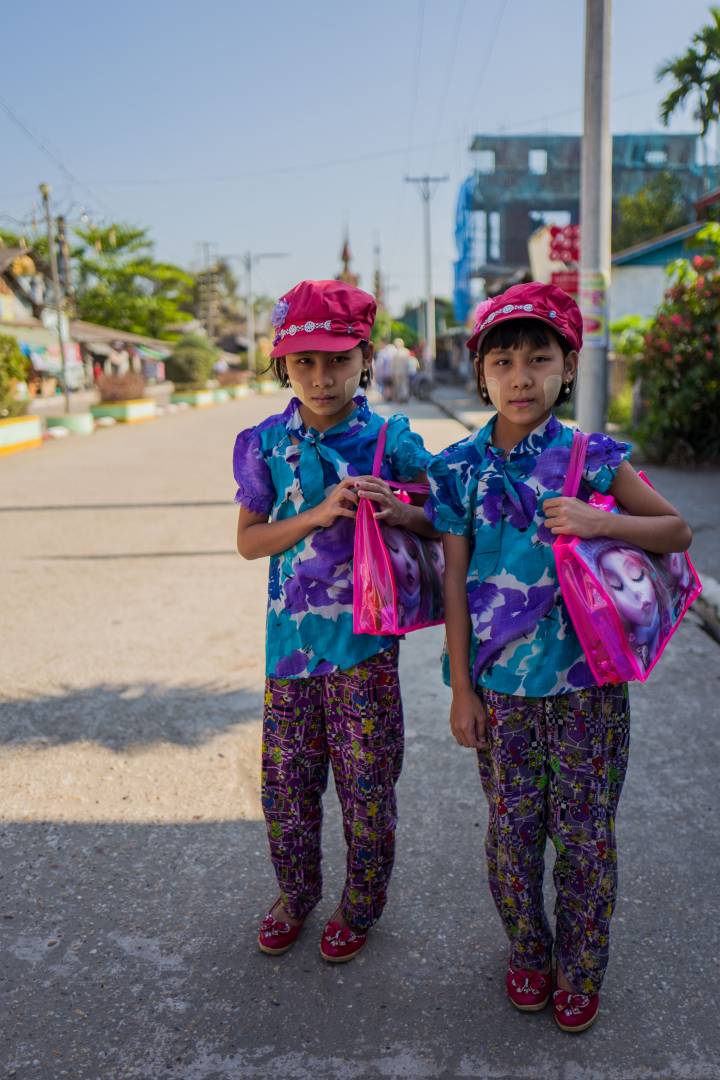I am not naturally a tidy person and my photo library — both physical negatives or slides and images on my computer — is a bit of a muddle.

But with the severe drought we are experiencing over most of Australia, there are few of those rainy days when I am stuck indoors and I have the “opportunity” to tackle onerous tasks such as clearing out cupboards or sorting the photo library. As a result, the muddle continues.

Actually the Lightroom library on my Mac is in reasonably passable shape although it is very big and finding individual photos is becoming increasingly difficult. In a half-hearted and belated attempt to limit the size of the library two years ago I started deleting all the photos I decided were not useful after a trip. But after doing this for two trips I decided that it was too time consuming and, very fortunately, discontinued the practice.

I was searching for a particular photo in the Lightroom library recently and I came across the series I had taken in Myanmar last year. I had previously thought that after the Myanmar trip I had really worked over all the usable photos but a closer look at the complete set revealed a few gems —either those I had missed previously or some which would benefit from different processing.
Mullock heaps
Perhaps this is the photographic equivalent of the people who go out to old mine sites and work over the mullock heaps — the spoil from the mines — looking for nuggets or gems the miners had missed.
The availability of affordable and more sensitive metal detectors has encouraged more and more amateur prospectors to work the mullock heaps on mines across Australia. Few find anything of value but sometimes they strike really lucky. If you want to see what a big nugget of gold looks like, check this short video.

Anyway, this is a belated selection of bonus photos from Myanmar 2018. Finding these has encouraged me to go through other rejected photos — my photographic mullock heap. Not every egg is a bird but it seems that there are more eggs with birds in them than I thought.
As I am fortunate still to be able to go globetrotting, I am constantly adding to my photo library and the latest images always seem more interesting than the older ones. However, the day will inevitably come when my globetrotting will be restricted or totally curtailed and then I will be glad that I kept all those images and I can spend some time usefully in picking out a few more nuggets.
The lesson to be learnt from all this is that fresh photographic inspiration may not have to wait for the next excursion with the camera. It may already be lurking undiscovered on your hard drive.
You can find more from John Shingleton, at The Rolling Road. And on Instagram.





John,
Those photos really are gems. We are very lucky indeed that you didn’t end up deleting them. The first two portraits are very special. I hope much rain comes your way. There will be the double benefit of putting out the fires and encouraging you to delve into those files a bit more.
Hi John,
I love it when we find those hidden gems we originally overlooked. I have a small bank of street stuff from a series of street events this year that I am trying to pull an article on.
I hope you have a great xmas and new year down under (and the rest of our Aussie contingent), despite the excessive heat and fire risk.
Dave
First and foremost, love the nuggets.
I have gone through a variety of approaches of trying to keep my Lightroom catalogue size to a manageable level. Earlier in the year I spent about two weeks in the evenings re-organising my file structure. I used to organise by year then topic of the shoot. I have gone to 7 or 8 broad categories such as Travel Australia, Travel Overseas, Sport, Animals, Music, Misc Events and Home (Family and Friends). In Lightroom you can then automatically sub-categorise by year/month etc using either meta data searches or smart collections based on the embedded date from the camera. The only other thing I do is assign a Place keyword when I first import the images. I find this combination means I can relatively quickly find most images. To cull my images when I feel the need I assign all the images in a shoot as 3 stars initially. Then as I move thru I assign x to those I will delete from my hard drive, 1 to those I will remove from Lightroom but leave on my hard drive (to avoid nugget regret), 2 to images that were deliberately shot for either panoramas or HDR brackets. That way I know I have another processing step to go. Everything else are my keepers. Prior to that I would spend endless hours culling (or curating if you want to be posh), keywording and applying star ratings.
I am typically shooting 4,000 to 6,000 images a year. I still feel it takes too much time, but it’s a vast improvement on a year ago. Maybe if I pressed the shutter button more judisciously that would help.
Hi Tom
I use a filing method that goes along the lines of – year/camera (so a df and x folder) and then I have seperate folders for any articles I write on here in that year. I also have a folder that is post processed images from the year, this is a mix of all images and where lightroom and now luminar dump my images once finished.
On the 1st Jan, I remove them from the ssd and put them on to a back up drive, and open a new folder for the new year.
I also keep time machine backups – so have technically got two backup of all my images back to 2016 when I last had a dig around in the time machine back ups.
I have around 15k of images per year on average.
Dave
Tom, it all sounds very methodical and time consuming. All credit to you. However I am astonished at your 6k images per year and even more astonished at Dave Seargants 15k images per year. When do you guys find time to eat and sleep?
I have travelled to far flung places for 11 weeks this year and have taken 2391 photos according to Lightroom. I try to pretend that I am using film when shooting and go for quality not quantity and even then I don’t look at them all.
I’ll be honest this year I tested the Df’s shutter to its limits at two separate events. Which didn’t do my SSD any favours. The last few months have been low shutter count owing to poor skies and poor weather, circumstances, or just bloody work getting in the way of my enjoyment.
I have gone back in recent months to less means more – which is my usual mantra. So the recent Dickens has a lowly 300 images. And a recent comic con event has around 100. I hope next year will be a more selective and lower image count year.
Had a quick look at my week in Yorkshire which produced my two previous articles, and it would appear I punched through around 1200 images for 7 days, or thereabouts.
Hello John, wonderful Myanmar pictures. Hard drives are full of nuggets although we sometimes just linger on the best images and forget about other images that are really worth. I particularly like the last image which reminds me of teak being unloaded on the banks of the Ayeyarwaddy further north near Mandalay. Thanks for sharing, Jean
Brian/Jean, thanks for your kind comments. The nuggets featured in the story were found when ironically I was forced to spend the day indoors not by rain but by bushfire smoke. It looks as if I may be spending Thursday indoors due to record high temperatures so I may well find some more nuggets. Since writing the story I have put up two more previously undiscovered photos on my blog at therollingroad.blogspot.com. These two were taken in Myanmar in 2012 using my X1 and one of them is definitely amongst my best photos. A little odd that I missed it at the time. So many photos ,so little time.
Hi John, absolutely lovely nuggets! I am jealous of your travel pictures as my travel days are over due to me being off warranty. I love your idea of searching for nuggets. Thanks, Brian